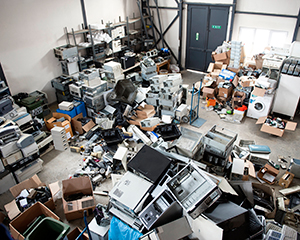E-waste Dumping: A Menace in the Developing Nations

Featured Image: iStock.com/baranozdemir
Due to rapid progression in technology, a vast variety of products and new versions of existing items are being launched continuously in the market. This advancement is increasing the link between the quality of life and owning such products.
People from all around the globe work hard to keep the newest versions of phones, computers, tablets and what not, because the rapidly advancing technology makes the e-products outdated only soon after their release.
Hence, the rate at which these e-products are being discarded is also quite dramatic. Every year, around 20 to 50 million tons of electronic goods are disposed and sent to the developing countries for recycling purposes where the unsafe reprocessing methods make way for detrimental consequences.
Why the Developing Nations?
The low-rate working conditions in the developing countries make this recycling of e-products cheap and easy there. Also, it has proven to be a lot cheaper to transfer the disposed electronic goods to the poor countries than to locally reprocess them.
The developing countries that serve as a common dumping ground include China, Pakistan, Brazil, Kenya, Ghana, Nigeria, India, and Philippines. China, however, is the most popular e-scrap destination amongst all of these countries.
Moreover, according to a rough estimation, around 70% of the total global e-scrap is entertained by China alone. The labor in these poor countries is poor and helpless enough to readily accept even the smallest amounts of money without enough stress on safety measures and equipments.
Is it Legal?
Yes, e-scrap exportation is officially permitted but under certain conditions which makes a large portion of it illegal. The e-goods that are categorized under “used” are legal to export, while, the ones that are, non-working in nature have been outlawed by the authorities.
How is it Recycled?
The reprocessing of e-scrap in the developing countries is indubitably posing a major threat to the human health as well as to the environment. The process of extracting the natural resources like gold, silver and copper from this waste is often done in the cheapest possible and most precarious of ways. Plastic is torched in open piles which spew toxic dioxin and metals like lead and mercury into the environment.
Likewise, in order to extract copper from the waste, cathode ray tubes are wrecked with hammers which releases the lethal phosphor grime. The workers involved are directly exposed to the lead fumes while the scorch the circuit boards over open flames.
Not only this, dangerous acid baths are also used to extort gold from the circuit board chips, which releases even more of lethal gases. This whole process of recycling releases an extensive array of metals not only into the air but also into soil and water that has disastrous implications.
What are the Consequences?
The workers that are involve in this precarious e-recycling process have become vulnerable to cancers, skin diseases, weak immunity, and nerve, brain, respiratory and kidney ailments and damage. Moreover, the most concerning part is that a good number of these workers are children who have little or no access to the safety equipments like the face masks or gloves.
The poor economical conditions of these countries make these workers too anxious to find labor and make ends meet to care about these health hazards. In addition, the process is also identified to be one of the major contributors to global warming.
The Final Word…
It might be next to impossible to impede all the exportation of this e-scrap; however, one can always take measures to make sure that the e-scrap is properly dumped and treated. The leading tech companies like Dell have proper recycling programs and have banned the export of non-working (illegal) electronics and e-scrap to developing nations. Therefore, it is important to ensure that you are giving out your disposed e-products to the certified electronic recyclers only.
About The Author Kelly Sampson
Kelly Sampson is a writer, blogger, and environmental enthusiast. She has strong opinions about climate change, the dogs vs. cats debate, and Oxford commas. She has lent Hummingbird International her engaging and spirited voice and turned our blog into a great place to find valuable information about e-waste, e-waste recycling, and the ITAD industry. Explore our blog to read more of her work.






